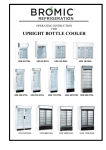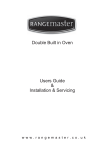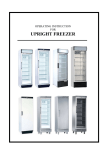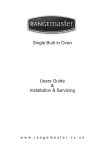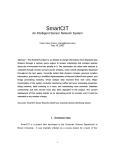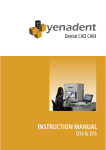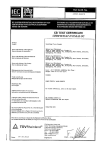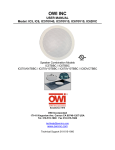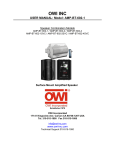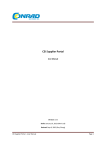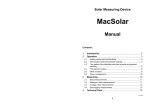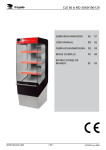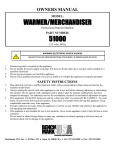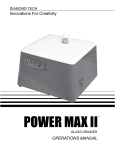Download Operator`s Manual
Transcript
Glass Door Refrigerator INSTRUCTIONS FOR INSTALLATION & USE Dear customer Please be sure to read this operating manual carefully before putting your new refrigerated cabinet into use. The manual contains important notes on safety and proper installation, use and maintenance of the plug-in refrigerated cabinet. Please keep the manual ready for reference and hand it over to any future new owner of the cabinets. Make sure the manual is read by all staff who may work with the merchandiser and that they understand and observe the contents. Should you or your staff be unable to understand any instruction in this manual, please contact your Service Organization. We would point out that the refrigerated cabinet is occasionally referred to on the following pages with options which do not form part of the standard equipment. Note for delivery On arrival, first inspect the refrigerated cabinet for any damage sustained in transit, All such damage must be reported immediately to your Service Organization. Contents Section Title page 1 Proper use 3 2 Safety regulations 3 3 Installation 4 3.1 3.2 3.3 3.4 3.5 3.6 Selecting the place of installation Stand-alone installation Hanging instructions (optional) Siting the cabinet Installation procedure Requirements for electrical connection 4 5 6 7 7 8 4 Starting 9 4.1 4.2 Measures prior to starting Setting into operation 9 9 5 Setting the storage temperature 10 5.1 5.2 Information on the product temperature Setting the temperature set point 10 10 6 Product loading and pricing 10 6.1 7 Loading the cabinet with products Evaporator Defrosting 10 11 8 Cleaning 12 8.1 8.2 Cleaning the outer casing Cleaning the internal surfaces 12 13 9 Maintenance 13 9.1 10 Cleaning the condenser Shut down 13 14 11 Troubleshooting 15 12 Environment protection and disposal notes 16 13 Regulations, standards, codes 16 14 Specifications 17 15 Drawings 18-19 1 Proper use The refrigerated cabinets USS as described in this operating manual are particularly intended for storing beverages in bottles or cans. Do not load the refrigerated cabinet with non refrigerated products or use it to cool products. Proper use only means the use as described above, adhering to the specifications on installation, connection, operation and service. Any other use is regarded as being contrary to specification and is prohibited. 2 Safety regulations The plug-in refrigerated cabinets as described in this operating manual are designed and manufactured in compliance with the international safety regulations. Like any electrical appliance, it must be handled with all due care, particularly with consideration to ensuring electrical safety. WARNING! To ensure safe operation in all service conditions, the following safety precautions must be observed: - - - The power plug must be connected in regulation matter and as instructed in this manual. If the power cable is damaged it has to be replaced by a qualified electrician or a person with experience in electrical engineering through a cable available from the manufacturer or Service Organization. Contact your Service Organization if you are in any doubt about electrical connection, working or safety of your plug-in refrigerated cabinet. Remove the cabinet from use if it is not working properly or exhibits any damage. Disconnect the power plug, transfer the merchandise to other cabinets or a cold-room and call your local Service Organization. When disconnecting the power plug, always pull on the plug itself and never the cable. Never detach any cover except where specifically instructed in this manual. Doing so might expose live electrical parts. If any damage occurs to the power cable, pull the plug to disconnect the cabinet. Never use a water hose or high-pressure jet to clean the cabinet. All work on electrical equipment must be left to a qualified electrician. Safety first! Never connect the cabinet to the power supply if it is damaged (in transit or otherwise). When in doubt, contact your Service Organization or dealer. Please pay attention to the maximum load limits when filling the display shelves or compartments with merchandise! See Chapter 15 Specifications! Electronic elements may only be replaced by a qualified electrician or person with experience in electrical engineering! WARNING! - - - Only for R600a and R290 flammable refrigerant. Keep clear of obstruction all ventilation openings in the appliance enclosure or in the structure for buildingin (IEC/EN 60335-2-89:2002) Do not use mechanical devices or other means to accelerate the defrosting process, other than those recommended by the manufacturer (IEC/EN 60335-289:2002) Do not damage the refrigerant circuit (IEC/EN 60335-2-89:2002) Do not use electrical appliances inside the food storage compartments of the appliance, unless they are of the type recommended by the manufacturer (IEC/EN 60335-2-89:2002) - - Appliances which use flammable insulation blowing gases, instructions shall include information regarding disposal of the appliance (IEC/EN 60335-289:2002) In order to reduce flammability hazards the installation of this appliance must only be carried out by a suitably qualified person (IEC/EN 60335-2-89:2002) 3. Installation 3.1 selecting the place of installation In selecting the place of installation, ensure that the following instructions are observed, this being vital for a proper and trouble free working of the cabinet: - Do not install the cabinet out-doors. Do not install the cabinet in the vicinity of heating radiators or other heat sources. Do not install the cabinet where it is exposed to direct sun light (e.g. through windows) Do not install the cabinet where it is exposed to drafts from ventilators or open doors Pay attention to air outlet from air conditioners/ ventilators. The following temperatures and air humidity’s apply as upper limits for the place of installation: 30 ºC, 55% rel. humidity Keep the air intake and outlet area around the plinth area of the cabinet clear of cartons and other obstacles. When installing the cabinet against a wall, make sure that the refrigeration unit fan is free to take in the ambient air from the room via the plinth area and discharge it through the ventilation slots on the back. In case of free-standing installation in a room, the original accessory rear wall panel must be screwed to the cabinet back. Adhere to the specified minimum distances! - When installing several cabinets alongside or behind one another, be sure to observe the specific installation plan. The drip tray may over-flow in extreme ambient conditions. We thus recommend that wall and floor surfaces in the installation area be chosen so that moisture or water have no damaging effects. 3 Installations Installation options are: - Stand-alone installation against a wall or in a corner In all installation options, air exit must be unhindered through the ventilation slots in the cabinet top to exclude accumulation of heat. Only then is trouble-free operation guaranteed. 3.2 Stand-alone installation When the cabinet is installed as a stand-alone unit against a wall, a min. distance of 50 mm must be maintained between cabinet back and room wall to ensure free air exit on the cabinet back. When the cabinet is installed as a stand-alone unit in a corner, no minimum distance between end wall and room wall is required. USS95xxxx have distance elements on the rear ex-works 3. Installation 3.3 Hanging instructions Figure 1 Drill 2 holes with the diameter of 7mm and a depth of 40mm to a surface which you are confident of its solidity according to your product on the A axis. Figure 2 Into the holes nail 8mm wall plugs on firmly. Figure 3 To the wall plugs fix 2 pieces of 4,8*38mm YSB DIN NO: 7981 screws. Figure 4 In order the hanger metal plates to fit onto the screws; it is needed to arrange a space of 23mm between the wall plug and the screw head. Note: Leaving the screw extended from the wall plug may cause cooler fall. Figure 5 Be sure that the slot hole on the hanger metal plates fit perfectly to the screw. You can axis the slot hole to the screw when hanging the cooler from the hole on the side of the metal plate. 3. Installation 3.4 Siting the cabinet The refrigerated cabinet should be best sited whilst still packed to avoid damages. If the refrigerated cabinet cannot be sited whilst still packed because of narrow doors the packaging and transport base should be removed beforehand. 3 Installation 3.5 Installation procedure - Remove packaging and transport guards. When lifting please consider the weight of the cabinet (see specifications). - Mount accessories as described in the specific mounting instructions. Only use original accessories to avoid possible damage to the cabinet. - Install cabinet at the desired location Observe specifications on the desired installation form. - Perform horizontal alignment of the registered cabinet on the sides and ends using water level. If necessary, correct height alignment per hand at the leveller feet. 3. Installation 3.6 Requirements for electrical connection The cabinet is connected by inserting the power plug in a socket. The cabinet must not be plugged into a multiple outlet power strip. The cabinet has no ON/OFF switch, which is why we recommend provision of a remote load-break switch. The remote switch must disconnect all poles of the cabinet from the mains, guarantee a contact opening width of at least 3mm and must be able to be secured against accidental reactivation. Please ask your electrician. The socket employed must be firmly installed, properly earthed and separately fuse-protected by a 16A-circuit breaker, type C. Supply voltage and frequency of the socket must be in accordance with the data shown on the type plate of the cabinet. Therefore, the cross-section of the wires must be increased, if necessary, for long wires to the socket. The local utility company’s regulations on the power connection 9e.g. earth-fault protection, additional equipotential bonding, and remote control switch etc.) must be observed. If in doubt, consult a qualified electrician. Run the power cables so that they are protected from risk of damage and there is no risk of tripping. The power cable may not come into contact with parts over 70 ºC. 4 Starting 4.1 Measures prior to starting If the cabinet has been sharply tilted while being sites on for mounting of accessories it must be left to stand for at least three hours before being started to allow the lubricating oil to settle in the compressor! Failure to do so can cause total destruction of the compressor refrigerating system. 4.2 Setting into operation Start the cabinet only if it has been installed as described. - Plug power plug in socket When selecting the socket, observe the requirements stated in section 4.6. The cabinet must not be plugged into a multiple-outlet power strip - Switch on remote control switch if provided. Starting is signalled by the low running noise of fans and refrigeration systems. The fan is stopped by a switch when door is opened. - Switch on cabinet lighting with switch and on the underside of the display superstructure. 5 Setting the storage temperature 5.1 Information on the product temperature A precisely defined product temperature is stipulated for the storage of each product group in refrigerated cabinets by the legislative bodies in EU states. This temperature range is shown on the digital thermometer. 5.2 Setting the temperature set point The internal temperature can be regulated only with thermostat. Pos 1 is maximum high temperature Pos 4 is best position for products Pos 7 is minimum low temperature 6 Product Loading 6.1 Loading the cabinet with products Reaching the prescribed storage temperature following the start of operation depends on the ambient temperature. Load the display compartment with the corresponding products. Ensure that a free circulation of air is possible between the products and the display rack above them. 7 Evaporator defrosting Defrosting of the ice and frost deposits that form on the evaporator and evaporation of the drip water that forms during defrosting is controlled by the temperature controller and carried out automatically. During automatic defrosting, the temperature in the display compartment may rise slightly. Defrost frequency as well as duration and time are factory-set. Defrosting is carried out automatically during the day, This is why no intervention is necessary in the cabinet. Defrost water is collected in a tray above the compressor. The defrost water that forms is automatically evaporated via the waste heat of the compressors. The defrost water tray should be cleaned at intervals. 8 Cleaning Turn off power supply to the cabinet by disconnecting the power plug before cleaning. When remote control switch is provided, this must be protected (e.g. by lock) against any unauthorised reswitching-in. Wear safety gloves when cleaning and servicing the device (risk of injuries). Do not use any aggressive or abrasive cleaning agents. Never use a water hose or a high pressure jet to clean the cabinet. 8.1 Cleaning the outer casing Wipe the outer casing with a cotton cloth moistened with lukewarm water. 8.2 Cleaning the internal surfaces - Remove the merchandise from the display compartment and transfer it to another storage place. Unplug power plug Do not start cleaning before the internal surfaces have risen near room temperature. Wear safety gloves when cleaning and servicing the device (risk of injuries). - Take accessories out of the display compartment. - Moisten cotton cloth with luke-warm water and a little detergent. Clean display compartment and display racks. Carefully dry display compartment with a dry cotton cloth. Carefully dry all cleaned surfaces with a dry cotton cloth. After cleaning, no humidity must remain in the display compartment. - Replace return air grille in reverse order and screw in again. Restart cabinet. The cabinet can be reloaded with refrigerated merchandise approx. 1…2 hours after putting into operation. Observe the instructions in section 7. 9 Maintenance Turn off power supply to the cabinet by disconnecting the power plug before starting any maintenance on the cabinet. When a remote control switch is provided, it must be protected (e.g. by lock) against unauthorised reswitching-in. Wear safety gloves when cleaning and servicing the device (risk of injuries). 9.1 Cleaning the condenser fins The refrigerated cabinet normally requires no maintenance except for cleaning the condenser fins twice or three times a year. - Disconnect cabinet as described above (see section 11). The condenser only needs cleaning when a layer of dust, fluff and the like begins to build up between the fins over the full width. Regular cleaning of the condenser is important to saving power and avoiding unnecessary servicing. 10 Shut down - Remove the merchandise from the display compartment and transfer it to another storing place. Unplug power plug or switch off remote control switch, if provided. If the cabinet is to be shut down for any length of time, proceed as follows. - Clean cabinet (see section 9). When cabinet is stored in a storage room: - Cover cabinet with a cotton sheet. Do not use plastic tarpaulins as these may encourage formation of moisture and odours inside the cabinet. 11 Troubleshooting Any trouble occurring might be due to a minor problem that you can correct yourself following the instructions below. Do not try any further action if the pointers given cannot solve the problem! Repairs on the cabinet must be made only by qualified specialists. Incompetent repair work can constitute a serious risk to you, your staff and customers, contact your Service Organization or Dealer for any repairs needed. 12 Environment protection and disposal notes UGUR refrigerated cabinets are designed to high standards of environmental protection and recycling convenience. Cyclopentane, an environmentally friendly foaming agent, has been in use. Cyclopentane is distinguished by zero ozone depletion potential (ODP) and zero global warming potential (GWP). The refrigerant used and contained within an hermetically tight circuit is environmentally friendly R134a and R600a, which does not contain chlorine and has zero ODP. The device must be disposed of in accordance with applicable regulations. The WEEE regulations must be observed. In the interest of preventing environmental nuisance and promoting re-use of the high-quality materials employed, used commercial refrigeration equipment must be collected for expert disposal and recycling. Therefore, observe the following disposal regulations: - The cabinet must not be discarded with regular municipal waste. The refrigeration circuit must not be damaged. Before discarding the cabinet for disposal, make it unserviceable by disconnecting the power plug and cutting off the power cable. Consult your local authorities or authorised UGUR dealer for details of collection and disposal facilities. Children are often unable to recognise the dangers associated with commercial refrigeration equipment. Proper supervision must be maintained and children must be prevented from playing with discarded refrigerated cabinets. 13 Regulations, standards, codes The plug- in refrigerated cabinet is intended for commercial use in the food trade has been designed and manufactured in accordance with the standards governing such use. In particular, it has been designed and manufactured in compliance with the provisions required under the German Equipment Safety Law (GSG), the VDE Electrical Codes and the provisions of the European EN standard for refrigerated display cabinets. The refrigeration circuit have been subjected to leak test. This appliance complies with EC Directive on Machinery 98/37/EC, the EC Directive on the Electromagnetic Compatibility 89/336/EEC, and the EC Directive on Low Voltage 73/23/EEC.











